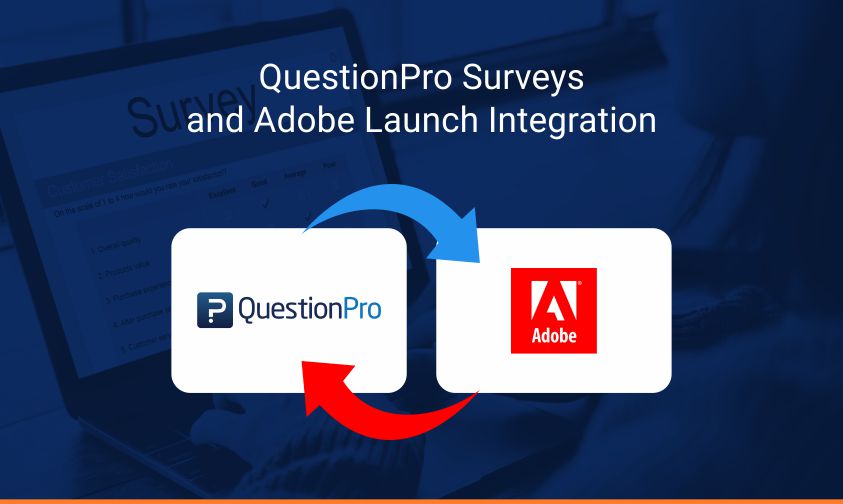 Reading Time: 4 minutes read
Reading Time: 4 minutes readIndustry adoption for online surveys has grown drastically in the past few years. And why not? They’re easy to deploy, incredibly inexpensive, reach a large and increasingly representative audience, and provide almost real-time information. By using online survey research, you can easily identify the core demography, and visit intent of your website visitors and also measure the overall website satisfaction and brand impression. It’s a dream come true for marketers.
With some savvy use of sampling and serving techniques, the brand impact can be determined by understanding how impactful was the experience of visiting your website for the user. If you ask a string of questions, you can even get a pretty good sense of how specific elements of your site like the navigational structure or the search or the section devoted to topic X were rated by your visitors.
Why is QuestionPro’s integration with Adobe Launch Survey Tool needed?
-
The Missing Link
But what’s missing in all of this, is an understanding of what these visitors actually did on your site and how the attitudes, ratings, and demographics captured in your survey which governed the real site experiences.
As a marketer do you know why a visitor is extremely satisfied or dissatisfied with your website? Can you tell, among the 50,000 different types of searches on your site which ones help create satisfaction and which ones help create the reverse? Can you tell if visitors even did what they said they were doing?
-
What Behavioral Data is Lacking
You may be surprised to learn that those of us who deal primarily with behavioral data have almost a perfectly symmetrical set of problems.
Did they leave the site because they found what they were looking for? Or did they exit because they couldn’t find what they were looking for? From the actual behavior, it’s impossible to know. We know a visitor made a purchase. But did they end up buying despite their frustrations? Did they walk out of our site less happy than when they went in?
From the actual behavior, it’s impossible to know. What we measure as a success using behavioral data might actually have been a significant failure.
So, there’s a lot that students of traditional survey research can learn from behavioral analysis. And there is just as much that students of behavioral analysis can learn from online survey research.
Wouldn’t it be nice if you could combine the two sets of data? If you could see how the people who searched for Product X rated search vs. the people who searched for Service Y? If in any research you were doing, you could see the behavior, the attitudes, and the demographics of the visitors involved?
-
Nobody needs the Traditional Surveys
What is common between Uber, Airbnb, Doordash, Yelp, and Expedia? They all have a tremendous focus on collecting attitudinal data. By attitudinal data we mean, how people feel and what is their cumulative experience for a given action. Surveys are morphing into segmented data collection at very specific moments of truth.
- When we finish an Uber ride
- When an Airbnb renter is done with the whole renting process
- After dinner at a restaurant
- Upon completion of an Expedia initiated trip.
Surveys are also evolving into transactional data collection points. This means the traditional model of asking 20 questions is dead. But the new mechanism of collecting the relevant data at the right time to the right people is alive and kicking and is a competitive edge for marketers.
-
Micro-Targeting
Most marketers have realized by now that sending an overall survey to collect data across all their constituents is a futile exercise. However, with Adobe Launch Survey Tool or Adobe DTM Survey, marketers can create very specific behavioral segments based on how people act on their website. This means that marketers can look at behavioral patterns and then track users based on a behavior. Adobe Launch Survey Tool makes it easy for marketers to create an infinite set of customer rules and triggers, based on Cookies, Sessions, and sites visited, based on locations and paths.
QuestionPro integration with Adobe Launch
Now with the launch of extensions and with the QuestionPro Surveys extension, marketers can deploy surveys to their website visitors with ease. The same micro-targeting rules that Adobe Launch Survey Tool enables can be used to target surveys at different points of the customer journey to measure and gain insight into the experience.
QuestionPro’s CX Intercept extensions can be applied towards Website Satisfaction, Usability Feedback, Net Promoter Score, Customer Satisfaction, Exit Survey, Cart Abandonment Surveys, Customer Demographics, and more.
-
Integrated Delivery:
The QuestionPro Surveys Extension for Adobe Launch Survey Tool enables a survey extension for all Adobe customers to use a point and click mechanism to deploy customized surveys for different segments of the audience. The Launch Extension platform has enabled QuestionPro to focus on the data-collection and survey delivery model, while Adobe DTM Survey handles the rules, criteria and targeting infrastructure.
With an automated APP/API model, QuestionPro can continuously focus on the survey delivery and data collection models while Adobe Launch Survey Tool has a repository of targeting rules and criteria. This division of labor is healthy for the long-term success.
Furthermore, with the Adobe DTM Survey Extension model, there is no need for API and Integrations it’s already done for the marketers. Typically, customers needed to cut-paste javascript code to deploy surveys at specific touch points but, with the extension modeling, this whole step has been eliminated. This makes adoption and even try-buy approach financially feasible.
-
Conclusion & Next Steps
As part of the Beta/Pilot program for Adobe Launch Survey Tool, we here at QuestionPro are giving our Intercept & CX platform free through the end of 2017.
If would like to try Adobe DTM Survey/ Adobe Launch Survey Tool + QuestionPro Surveys Extension – please contact [email protected].























